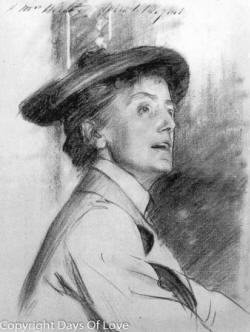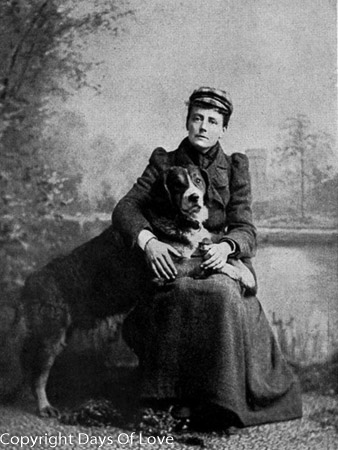

Queer Places:
Brettanby Cottage, Hook Heath Rd, Woking GU22 0QE,
UK
University of Music and Theatre Leipzig, Wächterstraße 11, 04107 Leipzig, Germania
40 Moore St, Chelsea, London SW3 2QW, UK
Frimhurst, Guildford Rd, Frimley Green, Camberley GU16 6NN, UK
University of Oxford, Oxford, Oxfordshire OX1 3PA
 Dame
Ethel Mary Smyth, DBE (22 April 1858 – 8 May 1944) was an English composer and
a member of the women's suffrage movement. Ethel
Smyth, who contributed the suffrage anthem, The March of the Women, was
well known for her attraction to other women and may have had an affair with
Emmeline Pankhurst. She was friends with
Edith Somerville and
Virginia Woolf. She is
caricatured as Edith Staines in E.F. Benson's
Dodo (1893).
Dame
Ethel Mary Smyth, DBE (22 April 1858 – 8 May 1944) was an English composer and
a member of the women's suffrage movement. Ethel
Smyth, who contributed the suffrage anthem, The March of the Women, was
well known for her attraction to other women and may have had an affair with
Emmeline Pankhurst. She was friends with
Edith Somerville and
Virginia Woolf. She is
caricatured as Edith Staines in E.F. Benson's
Dodo (1893).
Ethel Smyth’s autobiography discussed her own sexual affairs with women in coded terms but openly described how her mother, Emma Struth Smythe, and the children’s author Juliana Ewing “were attracted to each other at once and eventually became great friends”. Ethel Smyth worked with Cicely Hamilton (Hamilton put words to Smyth’s suffragist melody March of the women, which Smyth is renowned for conducting with a toothbrush in Holloway prison), often wore men’s clothes and had multiple passionate attachments to women, including Emmeline Pankhurst and Virginia Woolf. Woolf, who was flattered by Smyth’s attention, called her a ‘valiant truculent old mosstrooper of a woman’; watching Smyth conduct her music with a pencil, with a drip at the end of her nose and knocking her hat from side to side, Woolf wondered if Smyth might actually be a great composer.
Smyth was born in Sidcup, Kent, which is now in the London Borough of Bexley, as the fourth of a family of eight children of Major-General John Hall Smyth (1815–1894) and his wife, Emma Struth Smyth (1824–1891). While April 22 is the actual day of her birth, Smyth habitually stated it was April 23, the day that was celebrated by her family, as they enjoyed the coincidence with William Shakespeare's.[2] Her father, John Hall Smyth, who was a major general in the Royal Artillery, was very much opposed to her making a career in music.[3]
Undeterred, Smyth was determined to become a composer, studied with a private tutor, and then attended the Leipzig Conservatory, where she met many composers of the day. Her compositions include songs, works for piano, chamber music, orchestral and concertante works, choral works, and operas. In Leipzig she met her first lover, Elisabeth "Lisl" von Herzogenberg. Smyth once admitted, "If ever I worshipped a being on earth it was Lisl." However, in 1882, on a visit to Florence, Smyth was introduced to Lisl's sister, Julia Von Stockhausen, and Julia's husband, Henry Bennet Brewster, a writer and poet. At first it was Julia who was interested in Smyth, but in the end it was Henry who fell in love with her. Two years later, Smyth clained to reciprocate his feelings. Lisl died in 1892 and Julia in 1896. Henry proposed Ethel, but she refused. Henry died of cancer in 1908. Once Vernon Lee asked Smyth, "to how many people have you given without reserve and got something like the equivalent in return?", and Smyth replied: "Lisl, Harry and a third, unnamed, person." Lee deduced the third person was Lady Mary Ponsonby, Queen Victoria's lady-in-waiting.

In the early 1890s, she met the Benson family. She had an affiar with Nellie Benson, but also with Nellie's mother, Minnie Benson. When E.F. Benson's first novel, Dodo, was published in 1893, Smyth was immortalized as the central character's "candid friend", Edith Staines.
On the night of the Decennial Census in Britain in 1911, enumerators were sent out to collect details of every household in the country; the suffragettes mounted their refusal to participate – ‘If women don’t count, neither shall they be counted’. On that night, the composer Ethel Smyth stood with her friend Emmeline Pankhurst at the window to watch the dawn. In their dressing gowns, they saw the sun rise beyond the river and fight its way through the mist. ‘She was on the eve of some terrible venture that would end in rough usage and prolonged imprisonment,’ recalled Smyth of her friend. It was a collective struggle, a memorable and meaningful one. Their foreheads pressed against the window, they realized that Pankhurst’s championing of downtrodden women, her hope of better things to come, Smyth’s music and their friendship, were all ‘part of the mystery that was holding our eyes. And suddenly it came to us that all was well; for a second we were standing on the spot in a madly spinning world where nothing stirs … Neither of us ever forgot that dawn.’
Ethel Smyth lived at Frimhurst, near Frimley Green[4] for many years, but from 1913 onwards, she began gradually to lose her hearing and managed to complete only four more major works before deafness brought her composing career to an end.[3] However, she found a new interest in literature and, between 1919 and 1940, she published ten highly successful, mostly autobiographical, books.[3]
In recognition of her work as a composer and writer, Smyth was made a Dame Commander of the Order of the British Empire (DBE) in 1922,[3][5] becoming the first female composer to be awarded a damehood.[6] Smyth received honorary doctorates in music from the Universities of Durham and Oxford.[7] She died in Woking in 1944 at the age of 86.[8]
Smyth had several passionate affairs in her life, most of them with women. Her philosopher-friend and the librettist of some of her operas, Henry Bennet Brewster, may have been her only male lover. She wrote to him in 1892: "I wonder why it is so much easier for me to love my own sex more passionately than yours. I can't make it out, for I am a very healthy-minded person."[20] Smyth was at one time in love with the married suffragette Emmeline Pankhurst. At age 71, she fell in love with writer Virginia Woolf — herself having worked in the women's suffrage movement[21] — who, both alarmed and amused, said it was "like being caught by a giant crab", but the two became friends.[16] Smyth's relationship with Violet Gordon-Woodhouse is depicted satirically in Roger Scruton's 2005 opera, Violet.
Vernon Lee lived most of the time in Italy, where she was much given to visiting churches, museums and galleries; doing this in the 1890s with her lover, the painter Clementina Anstruther-Thomson, she decided to undertake a study of what happens to the human body when the mind is occupied with the vista of an aesthetic object: a building, a decorative jar, a painting. Anstruther-Thomson kept a diary in which she recorded her reactions, how looking at art made her feel. She noted her respiration and heart rate, balance, muscular tension, the manner and speed with which her right and left lungs filled with air. For example, looking at the Gothic-Renaissance façade of Santa Maria Novella in Florence one day, she observed that her balance changed and her breathing deepened. The composer Ethel Smyth, who had also had a relationship with Lee, made snide comments about what Lee and Anstruther-Thompson were doing, ‘experimenting’ in art galleries.
Ethel Smyth's sister, Nina Hollings became the longtime companion of Lady Helena Gleichen ( a great niece of Queen Victoria and cousin of George V).
Smyth was actively involved in sport throughout her life. In her youth, she was a keen horse-rider and tennis player. She was a passionate golfer and a member of the ladies' section of Woking Golf Club, near where she lived. After she died and was cremated, her ashes were, as she had requested, scattered in the woods neighbouring the club[7] by her brother Bob.[19]
My published books: